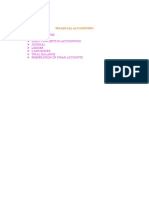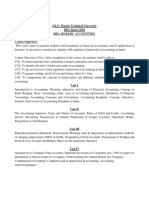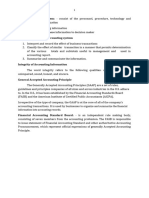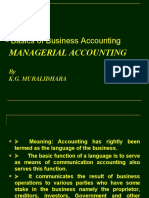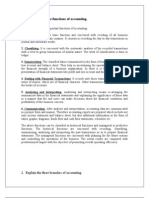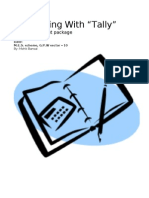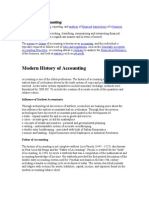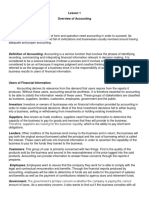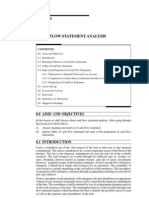0 ratings0% found this document useful (0 votes)
101 viewsFinancial Accounting - I Short Question & Answer Type CHAPTER - 1 - Introduction To Accounting
Financial Accounting - I Short Question & Answer Type CHAPTER - 1 - Introduction To Accounting
Uploaded by
Pooja PandeyThis document provides an overview of key accounting concepts covered in several chapters:
1) It defines accounting objectives, the differences between financial and management accounting, accounting information and its users/uses.
2) It describes the double-entry bookkeeping system, accounting equation, accounting cycle and key books of accounts.
3) It discusses the different bases of accounting, Generally Accepted Accounting Principles (GAAP), and revenue and expense recognition principles.
4) Key concepts covered include assets, liabilities, equity, transactions, events, gains, revenues, accrual vs. cash basis accounting and accounting standards.
Copyright:
© All Rights Reserved
Available Formats
Download as PDF, TXT or read online from Scribd
Financial Accounting - I Short Question & Answer Type CHAPTER - 1 - Introduction To Accounting
Financial Accounting - I Short Question & Answer Type CHAPTER - 1 - Introduction To Accounting
Uploaded by
Pooja Pandey0 ratings0% found this document useful (0 votes)
101 views4 pagesThis document provides an overview of key accounting concepts covered in several chapters:
1) It defines accounting objectives, the differences between financial and management accounting, accounting information and its users/uses.
2) It describes the double-entry bookkeeping system, accounting equation, accounting cycle and key books of accounts.
3) It discusses the different bases of accounting, Generally Accepted Accounting Principles (GAAP), and revenue and expense recognition principles.
4) Key concepts covered include assets, liabilities, equity, transactions, events, gains, revenues, accrual vs. cash basis accounting and accounting standards.
Original Title
E-RESOURSE-G-0-9-5E51733D1DDF3
Copyright
© © All Rights Reserved
Available Formats
PDF, TXT or read online from Scribd
Share this document
Did you find this document useful?
Is this content inappropriate?
This document provides an overview of key accounting concepts covered in several chapters:
1) It defines accounting objectives, the differences between financial and management accounting, accounting information and its users/uses.
2) It describes the double-entry bookkeeping system, accounting equation, accounting cycle and key books of accounts.
3) It discusses the different bases of accounting, Generally Accepted Accounting Principles (GAAP), and revenue and expense recognition principles.
4) Key concepts covered include assets, liabilities, equity, transactions, events, gains, revenues, accrual vs. cash basis accounting and accounting standards.
Copyright:
© All Rights Reserved
Available Formats
Download as PDF, TXT or read online from Scribd
Download as pdf or txt
0 ratings0% found this document useful (0 votes)
101 views4 pagesFinancial Accounting - I Short Question & Answer Type CHAPTER - 1 - Introduction To Accounting
Financial Accounting - I Short Question & Answer Type CHAPTER - 1 - Introduction To Accounting
Uploaded by
Pooja PandeyThis document provides an overview of key accounting concepts covered in several chapters:
1) It defines accounting objectives, the differences between financial and management accounting, accounting information and its users/uses.
2) It describes the double-entry bookkeeping system, accounting equation, accounting cycle and key books of accounts.
3) It discusses the different bases of accounting, Generally Accepted Accounting Principles (GAAP), and revenue and expense recognition principles.
4) Key concepts covered include assets, liabilities, equity, transactions, events, gains, revenues, accrual vs. cash basis accounting and accounting standards.
Copyright:
© All Rights Reserved
Available Formats
Download as PDF, TXT or read online from Scribd
Download as pdf or txt
You are on page 1of 4
FINANCIAL ACCOUNTING – I
SHORT QUESTION & ANSWER TYPE
CHAPTER – 1 - Introduction to accounting
1. Mention two objectives of accounting?
a. Recording the transactions in the primary books of accounts.
b. Ascertaining the operating results and financial position of the entity.
2. State two differences between financial accounting and management accounting?
F.A. M.A.
It is concerned with the recording of It deals with the presentation of accounting
transactions in the books of accounts. information to assist the management in day
to day operations, planning etc.
It generates fresh information that is useful to It utilizes information generated by
management accounting. financial accounting & cost accounting.
3. What do you mean by accounting information?
Accounting information refers to the information generated by the accounting system of an
entity relating to a particular accounting period for disclosing the operating results and
financial position of the entity to its stakeholders.
4. State two users of accounting information?
a. Internal users: owners or promoters, management.
b. External users: Investors or creditors, government.
5. State two uses of accounting information?
a. Financial performance measurement.
b. Financial analysis for decision making.
6. Mention two quantitative characteristics of accounting information?
a. Reliability.
b. Relevance.
7. What is comparability in accounting information?
It is a quality of the relationship between two or more pieces of information which enables
to understand the similarities in and difference between two sets of financial information.
8. What are the types of comparability of accounting information?
a. Horizontal: for comparing two or more entities pertaining to the same accounting period.
b. Vertical: for comparing single entity over different accounting periods.
9. Mention four different branches of accounting?
a. Financial accounting,
b. Cost accounting,
c. Management accounting,
d. Environmental accounting.
CHAPTER – 2- Double entry book-keeping system
1. State two difference between transaction and event?
Transaction Event
Measurable in terms of money. May or may not be measured monetarily.
All transactions are events. All events are not transactions.
2. What do you mean by Double entry book keeping system?
It is a system of accounting where both the aspects of every transactions are recognized and
recorded in the accounts.
3. State two features of double entry system?
a. It recognizes the records both aspects of transaction.
b. Every debit has an equal amount of credit.
4. Mention two characteristics of assets?
a. Assets are controlled by an entity as a result of past events.
b. Future economic benefits are expected to flow to the entity from such assets.
5. What are intangible assets?
An intangible asset is defined as an asset that is:
a. An identifiable non-monetary assets,
b. Without physical substance and
c. Held for production / supply of goods & services, for rental to others or for
administrative purpose.
6. Give two examples of tangible and intangible assets?
a. Tangible – building, machinery.
b.Intangible – goodwill, patent.
7. What are fictitious assets?
These are items reflected in the asset side of a Balance Sheet that:
a. Do not have any physical substance and
b. Don not have any realizable value.
8. What is a contingent asset?
An item is considered as a contingent asset if it has the following features:
a. It is a possible asset that may arise out of past event.
b. Its existence will be confirmed only by occurrence of future event. And
c. Such future event is not wholly within the entity’s control.
Ex: amount involved in litigation in favour of the entity, damage claimed from
customer forum.
9. What is contingent liability?
It is not an actual liability as yet but may turn to an actual liability on the occurrence of some
uncertain contingencies in near future. Ex – liability for bill discounting, liability as a
guarantor.
10. Distinguish between revenue and gain?
Revenue Gain
It means gross inflow of cash, receivable or other It is referred as that profit which are not
consideration arising in the course of ordinary generated through regular business
activities of an entity. activities.
It is a gross concept. It is a net concept.
11. What is accounting equation?
The equality which represents the relationship between asset, liabilities and equity
(capital) is known as accounting equation.
ASSETS = LIABILITIES + EQUITY (CAPITAL)
12. What is accounting cycle?
It is the complete sequence of recording, classifying and summarizing transactions that is
repeated in the same order in each accounting period.
13. Why journal is called the book of original entry?
All transactions are first recorded daily on a chronological order together with a short
description in the journal so it is called the book of original entry.
14. What is journal proper?
Journal proper / General journal / Residual book is a book of primary entry for those
transactions that are recorded in any specific subsidiary books.
Moreover the transaction for which no separate book of primary entry is maintained
gets recorded in journal proper.
Ex – opening entry, closing entry, adjustment entry and rectification entry.
15. What do you mean by balance of an account?
The difference between two sides of a ledger account is its balance and the process of
equalizing its two sides is called balancing.
16. Why ledger is called the book of final entry?
After journal ledgers are prepared and it is the final destination of all accounts and hence
it is the book of final entry.
17. What is a compound entry?
A journal entry having more than two accounts it is known as compound entry.
18. Can real account show credit balance?
Real account includes assets, liabilities and capital. Asset cannot show credit balance but
liabilities can.
19. Mention two errors that are not disclosed by the Trial Balance?
a. Error of commission and
b. Error of principles.
CHAPTER – 3 – Basis of accounting
1. What is cash basis of accounting?
Under this basis a transaction is recognize and recorded in the books of accounts only on
their actual receipt or actual payment in cash.
2. What is accrual basis of accounting?
Under this basis a transaction is recognized and recorded in the books of accounts on their
occurrence. Here revenue is recognized when (time period) it is earned and expenses are
recognized as they are incurred (time period).
CHAPTER – 4 – Concepts and convention
1. What is GAAP?
GAAP is Generally Accepted Accounting Principles. It refers to the common set of
accounting principles, standards and procedures that are used by accountants to prepare
the financial statements.
CHAPTER – 5 – Revenue recognition
1. What is meant by revenue in accounting?
According to AS-9, revenue is the gross inflow of cash, receivables, or other
consideration arising in the course of the ordinary activities of an enterprise from the sale
of goods, from the rendering of services and from the use by others of enterprise
resources yielding interest, royalties and dividend.
2. What is meant by recognition of revenue?
It refers to the earning of income by an entity from its ordinary activities and recording it
in the income statement when it is earned.
3. When should revenue be recognized in case of a concern engaged in rendering of
services?
Revenue from services is recognized as the service is performed. There are two methods
of measuring such service performances:
a. Complete service contract method
b. Proportionate completion method.
4. State when revenue should be recognized in the following cases:
a. Goods sold on approval basis
b. Goods produced under special order?
a. When confirmation from the buyer is received or the time period has expired.
b. When the goods are identified and ready for delivery.
5. What do you mean by expenses in accounting?
Expenses are outflow that result in benefits that are fully consumed, used or enjoyed
during a particular accounting period. This is also known as expired cost.
6. What do you mean by recognition of expenses?
The process of relating the expenses incurred to a particular accounting period is referred
to as recognition of expenses.
The expenses are required to be recognized and matched against the revenues
recognized for proper ascertainment of income.
You might also like
- Financial Accounting-Short Answers Revision NotesDocument26 pagesFinancial Accounting-Short Answers Revision Notesfathimathabasum100% (10)
- Basic Accounting Notes (Finale)Document33 pagesBasic Accounting Notes (Finale)Chreann Rachel100% (6)
- AP-200Q (Quizzer - Error Correction, Accounting Changes, Cash-Accrual & Single Entry)Document10 pagesAP-200Q (Quizzer - Error Correction, Accounting Changes, Cash-Accrual & Single Entry)Bernadette Panican100% (1)
- Accounting NotesDocument22 pagesAccounting NotesSrikanth Vasantada50% (4)
- Financial AccountingDocument11 pagesFinancial AccountingIshitaKothariNo ratings yet
- BBA 1st Sem. FULL SYLLABUS Basic AccountingDocument115 pagesBBA 1st Sem. FULL SYLLABUS Basic AccountingYash KhattriNo ratings yet
- Financial AccountancyDocument25 pagesFinancial AccountancyRAVI SHEKARNo ratings yet
- Bba 1sem Financial Accounting Important NotesDocument38 pagesBba 1sem Financial Accounting Important Notestyagiujjwal59No ratings yet
- 11 Accountancy - Introduction To Accounting - Notes and Video LinkDocument6 pages11 Accountancy - Introduction To Accounting - Notes and Video LinkKumar GautamNo ratings yet
- Financial and Management Accounting: Majlis Arts and Science College PuramannurDocument10 pagesFinancial and Management Accounting: Majlis Arts and Science College PuramannurhannnzzuNo ratings yet
- Notes - 3Document10 pagesNotes - 3valoansh19No ratings yet
- Accountancy Notes PDF Class 11 Chapter 1Document5 pagesAccountancy Notes PDF Class 11 Chapter 1Rishi Shibdat100% (2)
- BEFA - Unit-4 NotesDocument43 pagesBEFA - Unit-4 Notesmadddy0769No ratings yet
- 2 Marks Financial and Management AccDocument4 pages2 Marks Financial and Management Accmuhammadumaise06No ratings yet
- ACM Theory Solve by NafiDocument11 pagesACM Theory Solve by NafiAmitavo RoyNo ratings yet
- Sba 1102Document87 pagesSba 1102LogeshNo ratings yet
- 1.introduction To AccountingDocument14 pages1.introduction To AccountingBhuvaneswari karuturiNo ratings yet
- Financial Accounting TheoryDocument14 pagesFinancial Accounting TheoryNimalanNo ratings yet
- Accounting NotesDocument71 pagesAccounting Noteswaseem ahsanNo ratings yet
- Basics of Accounting and Book KeepingDocument16 pagesBasics of Accounting and Book KeepingPuneet Dhupar100% (1)
- Accounts AssignmentDocument28 pagesAccounts AssignmentAjay PradeepNo ratings yet
- Accountancy and ManagementDocument19 pagesAccountancy and ManagementLiwash SaikiaNo ratings yet
- BAM 1 - Fundamentals of AccountingDocument33 pagesBAM 1 - Fundamentals of AccountingimheziiyyNo ratings yet
- Accounting Notes For EE SubjectDocument32 pagesAccounting Notes For EE SubjectSanjay YadavNo ratings yet
- Part 1 - Acc - 2016Document10 pagesPart 1 - Acc - 2016Sheikh Mass JahNo ratings yet
- Business Accounting - BBA-IT 2Document8 pagesBusiness Accounting - BBA-IT 2Ishika SrivastavaNo ratings yet
- Introduction To AccountingDocument19 pagesIntroduction To Accountingkarn.sakshi05No ratings yet
- Fabm1 (Lecture)Document10 pagesFabm1 (Lecture)Cabaral Ashley RussellNo ratings yet
- Basic Accounting-Made EasyDocument20 pagesBasic Accounting-Made EasyRoy Kenneth Lingat100% (1)
- Fundamentals of Accounting Questions With AnswersDocument13 pagesFundamentals of Accounting Questions With Answersdhabekarsharvari07No ratings yet
- AfmDocument9 pagesAfmsimhamsidduNo ratings yet
- Fabm 2 and FinanceDocument5 pagesFabm 2 and FinanceLenard TaberdoNo ratings yet
- Finance Acc 2mark & 5mark ImportantDocument6 pagesFinance Acc 2mark & 5mark ImportantMADHANNo ratings yet
- Soln - Accountancy IntroductionDocument14 pagesSoln - Accountancy Introductionpeven28003No ratings yet
- A. BackgroundDocument8 pagesA. BackgroundBayu Sumber AbadiNo ratings yet
- Success Tree AccountingDocument206 pagesSuccess Tree AccountingManoj ReddyNo ratings yet
- IE132 Financial AccountingDocument8 pagesIE132 Financial AccountingAndrea Padilla MoralesNo ratings yet
- Fundamentels of Accounting Lect 1Document9 pagesFundamentels of Accounting Lect 1Jahanzaib ButtNo ratings yet
- Basics of Business AccountingDocument34 pagesBasics of Business AccountingMadhusmita MishraNo ratings yet
- Financial AccoountingDocument5 pagesFinancial AccoountingASR07No ratings yet
- 1Q) What Is Accounting State Its ObjectivesDocument9 pages1Q) What Is Accounting State Its ObjectivesMd FerozNo ratings yet
- Tally FinalDocument37 pagesTally FinalMohit Bansal0% (1)
- Modern History of AccountingDocument6 pagesModern History of AccountingShamim HossainNo ratings yet
- 61a6cbec682c8 - Book Keeping and AccountingDocument16 pages61a6cbec682c8 - Book Keeping and AccountingAnuska ThapaNo ratings yet
- Accounting System Short Notes Du Bcom Hons Chapter 1Document7 pagesAccounting System Short Notes Du Bcom Hons Chapter 1ishubhy111No ratings yet
- ch03 Intermediate AccountingDocument34 pagesch03 Intermediate AccountingMostafa MohamedNo ratings yet
- Principles of Accounts Syllabus Section 2Document5 pagesPrinciples of Accounts Syllabus Section 2Herve CharlemagneNo ratings yet
- Acctng1 Lesson 1-4Document28 pagesAcctng1 Lesson 1-4Icel EstoqueNo ratings yet
- Short 4 Marks Important Questions For SemDocument6 pagesShort 4 Marks Important Questions For SemonlygymislifeNo ratings yet
- Foundation Course NotesDocument29 pagesFoundation Course NotesPriya DharshiniNo ratings yet
- Accounting For Managers (AFM)Document100 pagesAccounting For Managers (AFM)Mansi Sharma100% (1)
- Vinayak 22251 Accounts 1Document5 pagesVinayak 22251 Accounts 1vinayakNo ratings yet
- Preparing Financial StatementDocument33 pagesPreparing Financial StatementkacaribuantonNo ratings yet
- Chap 1-4Document20 pagesChap 1-4Rose Ann Robante TubioNo ratings yet
- Prepare Financial Report IbexDocument13 pagesPrepare Financial Report Ibexfentahun enyewNo ratings yet
- Accountingformanager-Journal and ledgerDocument61 pagesAccountingformanager-Journal and ledgerselvisureshNo ratings yet
- MEFA UNIT-4 and UNIT 5 NotesDocument26 pagesMEFA UNIT-4 and UNIT 5 NotesRishitha ReddyNo ratings yet
- Entrep10q4W1 4Document12 pagesEntrep10q4W1 4bonifacio.gallardoNo ratings yet
- B. com FINANCIAL ACCOUNTING THEORY QUESTIONSDocument7 pagesB. com FINANCIAL ACCOUNTING THEORY QUESTIONSkeerthu2000kNo ratings yet
- In Final Fulfillment of The Curriculum Requirements inDocument56 pagesIn Final Fulfillment of The Curriculum Requirements inangelonoyasam16No ratings yet
- Accounting: Things You Should Know (Questions and Answers)From EverandAccounting: Things You Should Know (Questions and Answers)No ratings yet
- Bharat Case StudyDocument3 pagesBharat Case StudyPooja PandeyNo ratings yet
- BRM Assignment Group 6Document32 pagesBRM Assignment Group 6Pooja PandeyNo ratings yet
- Conceptual FrameworkDocument5 pagesConceptual FrameworkPooja PandeyNo ratings yet
- Prestige Institute of Management and Research, Indore: AssignmentDocument6 pagesPrestige Institute of Management and Research, Indore: AssignmentPooja PandeyNo ratings yet
- SMRDocument1,214 pagesSMRAnonymous B35kDvZNo ratings yet
- Power Electronics WorkbookDocument54 pagesPower Electronics WorkbookPooja PandeyNo ratings yet
- Nestle India Annual Report 2020Document136 pagesNestle India Annual Report 2020Pooja PandeyNo ratings yet
- Case Study FOmDocument2 pagesCase Study FOmPooja PandeyNo ratings yet
- Prestige Institute of Management and Research, IndoreDocument1 pagePrestige Institute of Management and Research, IndorePooja PandeyNo ratings yet
- Unit 12 Basic Concepts Relating To Final Accounts: StructureDocument8 pagesUnit 12 Basic Concepts Relating To Final Accounts: StructurePooja PandeyNo ratings yet
- (4 Marks) : © The Institute of Chartered Accountants of IndiaDocument25 pages(4 Marks) : © The Institute of Chartered Accountants of Indiapavan kumarNo ratings yet
- Itr 2024Document2 pagesItr 2024khananish1859No ratings yet
- Accounting Cycle Exercises IV PDFDocument47 pagesAccounting Cycle Exercises IV PDFhansrajhans tNo ratings yet
- Cabria Cpa Review Center: Tel. Nos. (043) 980-6659Document10 pagesCabria Cpa Review Center: Tel. Nos. (043) 980-6659MaeNo ratings yet
- Cheat SheetDocument262 pagesCheat SheetJada NelsonNo ratings yet
- Vardhman Textile Financial Ratio AnalysisDocument6 pagesVardhman Textile Financial Ratio Analysisnishant singhalNo ratings yet
- Golden Cushion CEO CompensationDocument24 pagesGolden Cushion CEO CompensationCityNewsTorontoNo ratings yet
- Particulars Dr. Cr. Amount (RS.) Amount (RS.) : © The Institute of Chartered Accountants of IndiaDocument9 pagesParticulars Dr. Cr. Amount (RS.) Amount (RS.) : © The Institute of Chartered Accountants of Indiaomkar sawantNo ratings yet
- Expand Your Critical ThinkingDocument5 pagesExpand Your Critical ThinkingISLAM KHALED ZSCNo ratings yet
- Weekly Exam 5Document9 pagesWeekly Exam 5Deyn EstoqueNo ratings yet
- Rajesh Patel ITR 04 23Document4 pagesRajesh Patel ITR 04 23The KingNo ratings yet
- Icse Maths Project-2021-22: Do Any Two Projects Out of FourDocument3 pagesIcse Maths Project-2021-22: Do Any Two Projects Out of FourAra ParkNo ratings yet
- British AirwaysDocument24 pagesBritish AirwaysHussain AsgharNo ratings yet
- Form Accepted Federal 2019 PDFDocument10 pagesForm Accepted Federal 2019 PDFRandy PettersonNo ratings yet
- Tb02 - Test Bank Chapter 2 Tb02 - Test Bank Chapter 2Document45 pagesTb02 - Test Bank Chapter 2 Tb02 - Test Bank Chapter 2Renz AlconeraNo ratings yet
- Test 1 Answer SheetDocument12 pagesTest 1 Answer SheetNaveen R HegadeNo ratings yet
- JOB ORDER-Rework Spoilage and EntriesDocument17 pagesJOB ORDER-Rework Spoilage and EntriesxjammerNo ratings yet
- 2016 CBI Study Guide - Questions and Answers - 16aDocument80 pages2016 CBI Study Guide - Questions and Answers - 16aGovil KumarNo ratings yet
- FOREX ACCOUNTING: Distributor Importer Business Problem 1Document2 pagesFOREX ACCOUNTING: Distributor Importer Business Problem 1Gloria Lisa SusiloNo ratings yet
- FM TheoryDocument23 pagesFM TheoryBhavya GuptaNo ratings yet
- Cert of Expenses Not Requiring Receipts TaclobanDocument8 pagesCert of Expenses Not Requiring Receipts TaclobanMark Anthony C. SaspaNo ratings yet
- Istilah Istilah EkoTekDocument24 pagesIstilah Istilah EkoTeki putu andre artha wardanaNo ratings yet
- Revised NRI-Account-Opening-Form-editable PDFDocument6 pagesRevised NRI-Account-Opening-Form-editable PDFSuprodip DasNo ratings yet
- Annual Report - 2020 - Linde Bangladesh BOCDocument90 pagesAnnual Report - 2020 - Linde Bangladesh BOCAtiqul islamNo ratings yet
- Cash Flow Statement AnalysisDocument11 pagesCash Flow Statement Analysisrscjat100% (1)
- 2, Questions and Answers 2, Questions and AnswersDocument35 pages2, Questions and Answers 2, Questions and AnswersCarlos John Talania 1923No ratings yet
- The Formation of The English Premier LeagueDocument21 pagesThe Formation of The English Premier Leagueajonyedaniel496No ratings yet
- FinMan CompreDocument15 pagesFinMan CompreDetox FactorNo ratings yet
- Mittal Steel in 2006: Changing The Global Steel Game: Presented By: Group 12Document6 pagesMittal Steel in 2006: Changing The Global Steel Game: Presented By: Group 12snehalNo ratings yet



